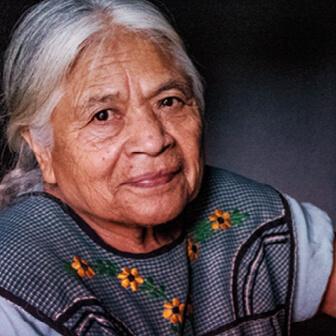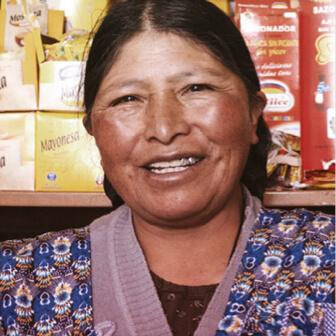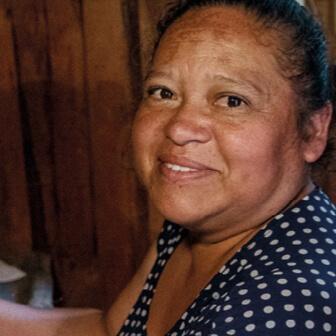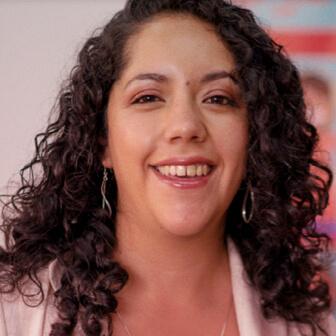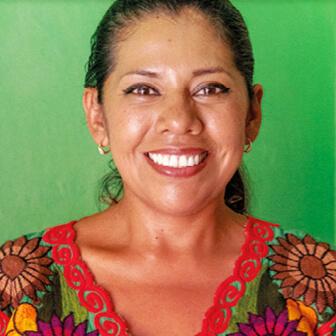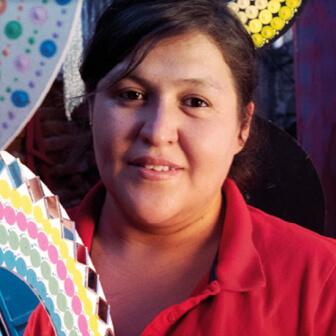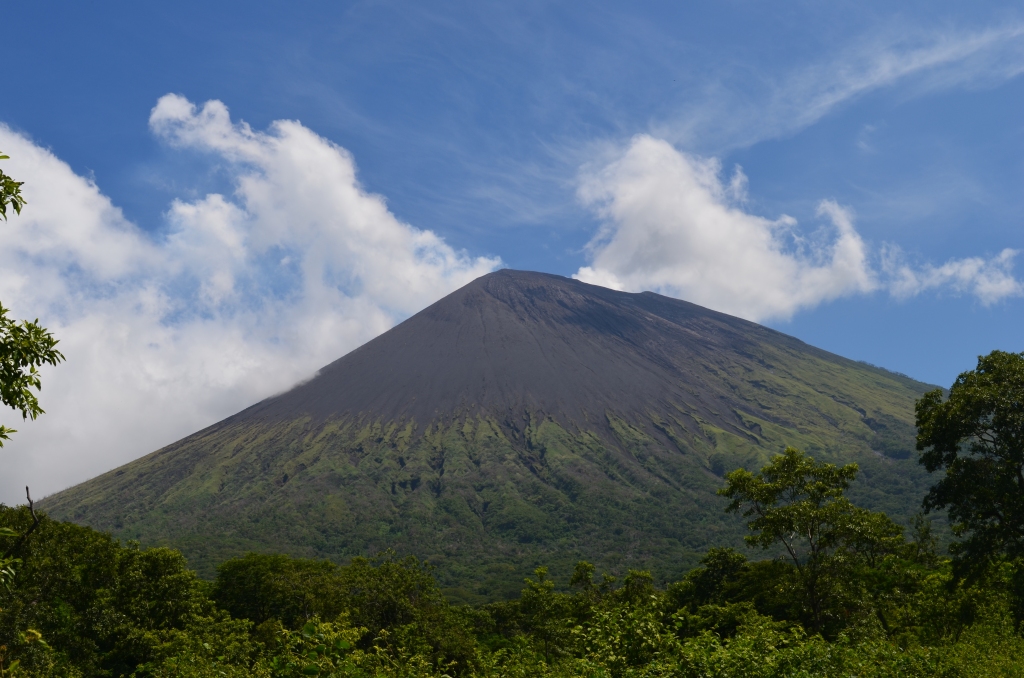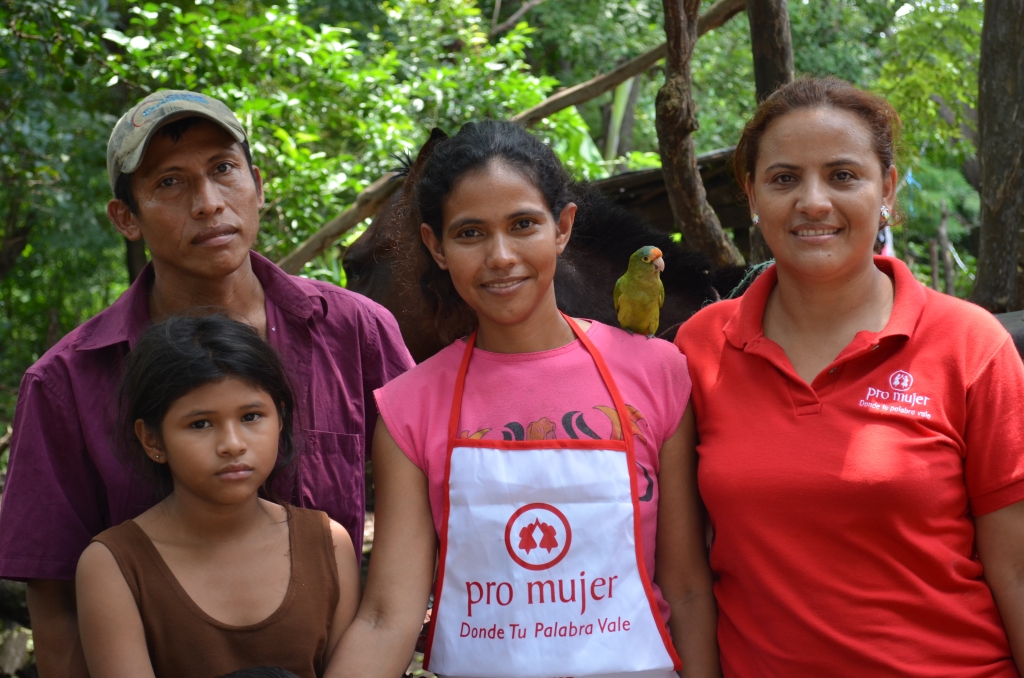In Chinandega, Nicaragua, the San Cristóbal Volcano Returns to a State of Calm
4 octubre, 2012
Blog, Breaking News, Voices from the Field
By Alejandra Narváez, Communications Specialist, Pro Mujer in Nicaragua
Sayda is a slender, 32-year-old mother of three from Chinandega, Nicaragua. She, her husband and their three daughters are the caretakers of the Las Uvitas farm, which perches approximately 1,968 feet up the flank of the gigantic San Cristóbal Volcano. At more than 5,725 feet above sea level, it is the highest volcano in Nicaragua.
Sayda, center right, with her husband and three daughters
In exchange for their work at the farm, Sayda and her husband receive a monthly salary of US$125, which is not enough to cover their basic expenses. Fortunately, Sayda has been receiving financial services, training and healthcare from Pro Mujer for the last few years. She used her first loan of US$125 to buy pigs, which she then raised and sold. With those profits she began making tortillas and nacatamales, a traditional nicaraguan food, which she sells once a week at the local market. Although the market is just 1.8 miles away, the roads are poor, and it takes her an hour to get there on horseback.
Sayda used her first loan of US$125 to buy pigs, which she then raised and sold
At the farm, she and her family plant onions, tomatoes, sweet peppers, corn, beans and a few other vegetables. The area, surrounded by hardwoods and laurels, is part of a nature reserve, and their agricultural practices are environmentally sustainable.
The air is fresh on the hillside where the farm sits, but on September 8th the volcano produced three large explosions, and began expelling large amounts of ash, while families like Sayda’s watched anxiously.
Even though they are accustomed to occasional expulsions of ash, Sayda and her family spent four suspenseful days waiting for the volcano to calm down. “The first day was the hardest, but we didn’t want to evacuate. We left our animals close to the house in case anything happened, prepared lanterns, and sat waiting because we could see the danger.”
The San Cristóbal Volcano
Fortunately, Sayda and her family did not suffer any material losses as a result of the volcanic activity. Further down the mountain, 44-year-old Victoria Lopez was not so lucky. Also a Pro Mujer client, Victoria regularly hosts bi-weekly meetings for the 21 members of her communal bank. Normally she sells cigarettes and candy to her neighbors, but many of her clients have evacuated, and her sales have plummeted.
The greatest impact for Victoria was her health – she is a diabetic and stress caused her blood sugar to rise. She was especially nervous when the first explosion happened and her husband and one of her sons were higher up on the mountain leading a group of tourists. In addition to the profits from her sales, her family also depends on agriculture – they grow beans and corn and were in the process of preparing the soil. This harvest will probably be a difficult one for them.
The region of Chinandega is vulnerable to earthquakes, volcanic eruptions and hurricanes; however, the areas that fall within a five-mile radius of the San Cristóbal volcano are considered to be particularly high risk, directly affecting the families that work on farms in the area. Pro Mujer has 94 clients in this high-risk zone, four of whom are in particular danger because they live near the mouth of the volcano. In total, Pro Mujer has more than 1,783 clients in the areas surrounding the volcano, and according to Nicaragua’s National System for Disaster Prevention and Mitigation (SINAPRED), all are at risk of being evacuated were a real volcanic eruption to occur.
Pro Mujer in Nicaragua Launches Contingency Plan
Pro Mujer in Nicaragua has identified its main risk factors as volcanic eruptions and earthquakes, for which the likelihood of occurrence is especially high in the western part of the country. As General Manager of Pro Mujer in Nicaragua Gloria Ruiz explains, a plan has been outlined to mitigate the impact of either of these potentially disastrous events.
“We have someone at the national level that is in charge of monitoring the threats and predictions for all of these crisis events. Each of our centers has a committee with a prepared plan of action, and each member has specific assignments depending on the case at hand: Some are responsible for ensuring the safety of personnel, some for protecting the organization’s assets, and others for monitoring our financial and health operations,” explains Gloria.
Sayda, center, poses with her husband, one of her daughters and Anexis, the Chinandega Focal Center Manager
Staff members in rural areas have clear directions regarding what to do in case of a disaster, but one of the most important is avoiding trips to risky areas when events are predicted that could put personnel in danger.
At each Pro Mujer center there is a complete set of guidelines that outlines what to do in case of each possible disaster: establishing a clear evacuation route, indicating those who will ensure communication, relocating operations, summoning medical care, transportation, etc.
Gloria explains that from the business department there are policies regarding flexible payments, repayment meetings or the extension of loan cycles, if necessary. Pro Mujer regularly offers information and advice to clients, encouraging them to join their local civil defense committees, which provide security and protection for the community.
“Pro Mujer has put a lot of emphasis on the safety and security of its personnel and its clients, who are the real priority of our contingency plans. Our second priority is to assure the continuity of the business, which is why our plans have been prepared with careful attention to detail and the active participation of our personnel,” says Gloria.
The San Cristóbal Watchman
70-year-old Vicente Pérez, the San Cristóbal Volcano watchman, is seated on an old wooden stool next to a table with a hand-held radio held together with tape to keep it from falling apart. Don Chente, as he is known in the area, tells me about his many adventures over the last 42 years that he has spent watching the volcano. The rumbling noises don’t worry him. “My work is to spend the day watching the gases that come out of the volcano, but once a month I climb up the mountain a ways and take the temperature of the crater and inform INETER (the Nicaraguan Institute for Territorial Studies).”
Smiling, he recounts the story of how he came to watch over San Cristóbal. He started with a monthly salary of US$2, and even after going down to Chinandega to buy food and supplies, he would still have some money left over. More than four decades have passed since then, and Vicente is now employed by INETER, where he earns a monthly salary of US$125, which he uses to support his wife and three children.
Vicente Pérez, the San Cristóbal watchman
Vicente recalls what happened on September 8th. “When I saw dark clouds coming out of the volcano, I called INETER and the Civil Defense Committee regarding the expulsion of material, sand and other things,” This activated the alarm and the attention of the media.
However, Vicente witnessed even more impressive volcanic activity in 1976, when San Cristobal produced large plumes of smoke and several explosions. He explains that on the eastern side of the volcano there used to be a large pine forest that disappeared as a result of the fumes and ash, which can prove even more destructive when it rains. The echos of the volcano’s explosions were loud, and the last rock that it erupted landed a half a mile from the mouth. If the volcano is inactive for a long time, the 400 or 500-pound rocks that it expels will devastate surrounding areas.
“It can be very dangerous, because the volcano acquires a disproportionate reserve of energy,” explains Vicente, who has only a thermometer and a radio to alert INETER and the Civil Defense Committee of the volcano’s status.
In 1976, the volcano formed another crater. Vicente explains that it damaged places where water could have entered, and when this happens, the volcano can convulse. “The magma is rising, and everything that is happening is making it rise faster. Five years ago it shot out flames.”
Almost everything has returned to normal in the San Cristóbal Reserve and nearby communities. Classes were suspended for nearly 12 days after the eruption of the volcano. A spokesperson for the government, Rosario Murillo, told the press that school will resume in the 18 municipalities of Chinandega, where some 3,000 people were evacuated from areas surrounding the volcano. But he assured that the preventive alerts in the western region of the country would be maintained as a precaution.
